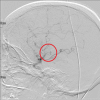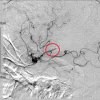Acute ischaemic stroke-related choreoathetosis treated with arterial thrombectomy
- PMID: 30700452
- PMCID: PMC6352821
- DOI: 10.1136/bcr-2018-226035
Acute ischaemic stroke-related choreoathetosis treated with arterial thrombectomy
Abstract
A rare case of acute choreoathetosis after acute stroke is presented. This 66-years-old, right-handed Caucasian woman presented with weakness of her right arm and right leg with dysarthria, which resolved by the time she arrived in the emergency department. No obvious focal sign apart from the abnormal choreoathetoid movement of the right arm and leg and of the neck was present. Her medical history included atrial fibrillation without anticoagulation. CT head was nil acute (Alberta Stroke Program Early CT Score of 10). CT angiography of the carotids showed a hyperdense M2 segment of the left middle cerebral artery. Intravenous thrombolysis immediately followed by thrombectomy was decided. Using the Penumbra aspiration device (ACE 68) two clots were removed with two aspirations. A small distal clot remained but partial recanalisation (Thrombolysis in Myocardial Infarction/Thrombolysis in Cerebral Infarction 2b) was achieved. 30 seconds after restoring blood flow, the choreoathetoid movements ceased. The patient was brought to intensive care for further monitoring, which was uneventful.
Keywords: movement disorders (other than Parkinsons); neuroimaging; stroke.
© BMJ Publishing Group Limited 2019. No commercial re-use. See rights and permissions. Published by BMJ.
Conflict of interest statement
Competing interests: None declared.
Figures





Similar articles
-
Emergent extracranial internal carotid artery stenting and mechanical thrombectomy in acute ischaemic stroke.Interv Neuroradiol. 2015 Apr;21(2):205-14. doi: 10.1177/1591019915583213. Epub 2015 May 5. Interv Neuroradiol. 2015. PMID: 25943850 Free PMC article.
-
Vessel perforation during withdrawal of Trevo ProVue stent retriever during mechanical thrombectomy for acute ischemic stroke.J Neurosurg. 2014 Oct;121(4):995-8. doi: 10.3171/2014.4.JNS132187. Epub 2014 Jun 13. J Neurosurg. 2014. PMID: 24926655
-
Left M2 Occlusion With Thrombolysis in Cerebral Infarction (TICI) 2b Recanalization Using "Solumbra" Technique: Video Case.Neurosurgery. 2019 Jul 1;85(suppl_1):S68-S69. doi: 10.1093/neuros/nyz082. Neurosurgery. 2019. PMID: 31197339
-
[Treatment of arterial and venous brain ischemia. Experts' recommendations: stroke management in the intensive care unit].Rev Neurol (Paris). 2012 Jun;168(6-7):512-21. doi: 10.1016/j.neurol.2012.01.587. Epub 2012 May 28. Rev Neurol (Paris). 2012. PMID: 22647807 Review. French.
-
Uneventful Pregnancy and Delivery after Thrombolysis Plus Thrombectomy for Acute Ischemic Stroke: Case Study and Literature Review.J Stroke Cerebrovasc Dis. 2019 Jan;28(1):70-75. doi: 10.1016/j.jstrokecerebrovasdis.2018.09.002. Epub 2018 Sep 27. J Stroke Cerebrovasc Dis. 2019. PMID: 30268366 Review.
Cited by
-
Hemichorea-hemiballismus as the initial manifestation of symptomatic middle cerebral artery dissection: A case report.Medicine (Baltimore). 2020 Sep 4;99(36):e22116. doi: 10.1097/MD.0000000000022116. Medicine (Baltimore). 2020. PMID: 32899095 Free PMC article.
References
-
- World Health Organization. WHO Surgical Safety Checklist [Internet]. 2018. http://www.who.int/patientsafety/topics/safe-surgery/checklist/en/ (cited 12 Nov 2018).
Publication types
MeSH terms
LinkOut - more resources
Full Text Sources
Medical
Miscellaneous
